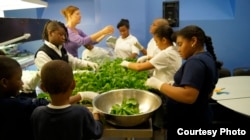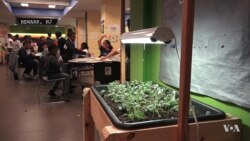One Newark, New Jersey, school is tackling America’s obesity problem.
Philip’s Academy Charter School, in the heart of the second-largest city in the New York metropolitan area, has established a first-of-its-kind curriculum that emphasizes healthy eating and food literacy. Its mission is to foster a future generation of environmental leaders.
Enter the dining room at Philip’s Academy, past a smiling portrait of then-Harvard student Barack Obama, and everything is green — from its lime walls to its salad and vegetable bar, with items seasonally grown from its rooftop garden. In the corner is an AeroFarms leafy green lab, operated entirely by middle school students.
The main dish is prepared and distributed differently, too — made from scratch, served family style — with an emphasis on communal preparation, cleanup and composting.
The menu on a recent day: oatmeal, scrambled eggs, sweet potato hash, English muffin and a smoothie made from pineapple, spinach and banana.
The academy’s educators say their approach to mitigating poor health and building sustainability is to establish a healthy connection to food.
“Our students from a really young age — from kindergarten, all the way up — are developing the skills and the knowledge to really address these issues,” said Frank Mentesana, director of EcoSpaces Education at Philip’s Academy.
“Through this program they are growing their food literacy [so] that they can make healthy choices about their own lives,” he added.
EcoSpaces Education is closely aligned with the “Let’s Move!” childhood health initiative established by first lady Michelle Obama to tackle childhood obesity in the United States. According to the American Heart Association, one in three U.S. children is overweight or obese, placing them at risk of diabetes, heart disease and high blood pressure, among other health problems.
Additionally, 7.9 million children live in food-insecure households across the country, unable to lead healthy, active lifestyles because of inadequate access to proper nutrition, according to a 2014 study by the U.S. Department of Agriculture.
Oasis in Newark
Catkin Flowers, an environmental science teacher at Philip’s Academy, instructs her students to monitor pH, nutrient and water levels at its indoor growing lab — a core feature of the school’s project-based learning structure — before harvesting and sharing the greens across the kitchen with “Miss Vanessa,” one of the school’s chefs.
Flowers describes the school’s growing lab and rooftop garden as an oasis for many of her Newark-native students.
“They come from areas where going to the local park isn't safe," and where they are unable "to just enjoy the same privileges that people in more suburban communities don't even think twice about,” said Flowers.
Seventh-grader Kailani Day, who one day wants to become an environmental scientist, said the school’s hands-on approach to harvesting and sustainability is not easy to find elsewhere.
“Having a rooftop garden or even an indoor garden is kind of rare in our community,” said Kailani. “This is a rare opportunity to have it in a closed area.”
WATCH: New Jersey School's Curriculum Focuses on Healthful Eating
Model school
Flowers' main objective is to get her students excited about wellness and sustainability, a goal she has achieved with sixth-grader Lael Beckles, who monitors the water level in the growing lab’s reservoir.
“Most schools can’t really afford to have this kind of machine in their school, so I think it’s a blessing that we have it here,” said Beckles.
“[Flowers] lets me check the pressure and clean the water that we use to build the plants,” added eighth-grader Robbie Riviere, who plans to research plants on a larger scale “for the future of everyone.”
Philip’s Academy is a model school for EcoSpaces Education, which incorporates lesson planning around wellness and sustainability throughout its core subjects — including English, math and art — in addition to science.
Aside from the school’s garden, growing lab and a specialized “EcoArts” studio, its rooftop features 12 solar panels, used to power classroom lighting fixtures, computers and smart boards.
Flowers says EcoSpaces’ project and service-based learning model is designed to be accessible in everyone’s lives outside the classroom, enabling students to transform not only their own health, but that of their families and larger community.
“We believe that if you can do it here, you can do it anywhere,” said Flowers. “We really want to be the model of changing the face of what education can mean towards transforming the health of our young people and developing the next generation of environmental leaders.”











